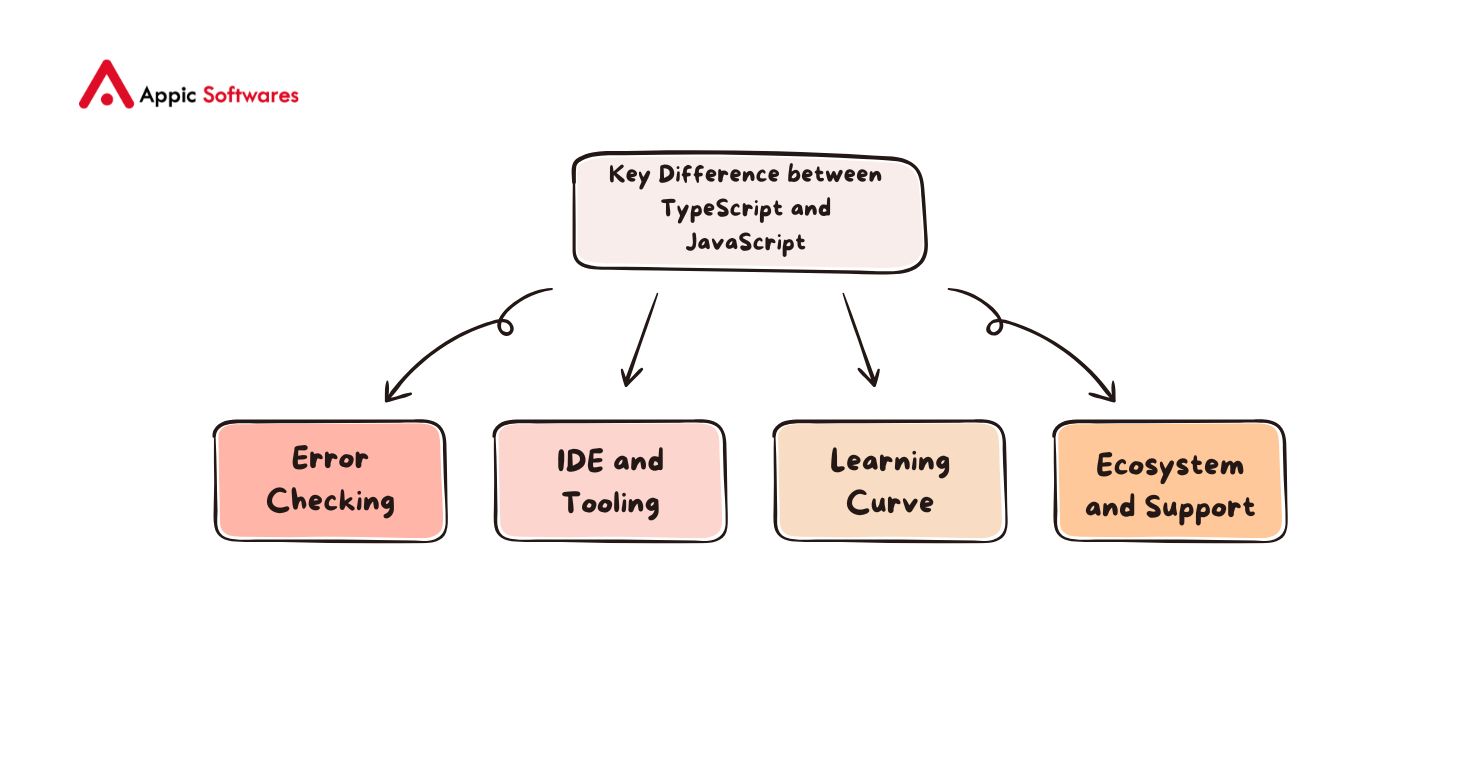
- In large-scale applications like java financial app development, where security and predictability are crucial, TypeScript can offer significant advantages. It adds a layer of stability that pure JavaScript might lack, especially when dealing with financial data.
JavaScript is a popular language capable of executing in a web browser and on servers as Node.js. It is a dynamic and high-level language, which means that you can write code rapidly without specifying the type of data that you are utilizing. This is convenient to begin implementing code. However, it also implies that JavaScript does not identify numerous errors until the code is executed. For example, you can take a variable, position a number in it, and then use it to put some text, and JavaScript will not make any fuss. It may mean that this flexibility results in certain bugs or possible errors at run time.
However, TypeScript, on the other hand, was developed by Microsoft to introduce structure and predictability to JavaScript programming. It is regularly characterized as an extension of JavaScript, indicating that any JavaScript program is a valid TypeScript program as well. However, TypeScript introduces additional tools to JavaScript.
TypeScript becomes especially powerful when used by companies looking to hire Indian developers to scale their teams cost-effectively while maintaining high code quality.
In this article, we explain what JavaScript and TypeScript each are and then cover their key differences in depth. You will learn how TypeScript builds on JavaScript by adding static types and a compilation step, and why developers often use TypeScript for larger projects.
What is JavaScript?
JavaScript (commonly known as JS) is the fundamental language on the web. It was created in 1995 and has since become the standard scripting language for web browsers. Today, JavaScript code runs in every modern web browser and also on servers via environments like Node.js. This makes JavaScript extremely versatile.
Some key features of JavaScript include:
-
Event-Driven and Asynchronous: JavaScript excels at handling user events (like clicks or form input) and asynchronous tasks (such as network requests) via callbacks, promises, and async/await. This makes it ideal for interactive web applications.
-
Interpreted Execution: JavaScript code is run directly by the browser or Node.js without needing to compile first.
-
Dynamic Typing: As mentioned, JavaScript variables can hold any type of data at runtime and can change type. This flexibility lets beginners start quickly, but it can also hide errors until the code runs.
-
Universal Support: Nearly every browser and many web tools support JavaScript out of the box. It has a vast ecosystem of libraries and frameworks (like React, Angular, and Vue) that developers use to build modern web apps.
-
Ease of Use: JavaScript’s syntax is relatively simple and forgiving. It does not enforce strict rules like declaring types, which lowers the barrier for learning and allows quick scripting. This ease is why JavaScript has become the most widely used language on the web.
This flexibility is also why JavaScript is often used when teams build an MVP and raise fund quickly before investing in long-term architecture.
What is TypeScript?
TypeScript (often written as TS) is a language that builds on JavaScript. It was created by Microsoft and first released in 2012. TypeScript is open-source and maintained by Microsoft. Developers can gradually introduce TypeScript into an existing JavaScript project. This means you can often take a .js file and rename it to .ts to start adding type annotations without breaking your code.
-
Static Typing (optional): You can declare variable types (number, string, etc.) and TypeScript will check them at compile time. This means many mistakes can be caught early.
-
Interfaces, Enums, and Generics: TypeScript introduces constructs like interfaces, enums, and generics to help define complex data structures and reusable code patterns.
-
Rich IDE Support: Code editors like VS Code have special support for TypeScript. They use the type information to provide autocompletion, real-time error checking, and easy navigation of your code.
-
Modern JavaScript Features: TypeScript includes the latest JavaScript (ES6+) features and can compile them into code that older browsers can understand. This means you can use new syntax like classes, arrow functions, or async/await even if you need to support older environments.
It’s also being adopted in industries like logistics and supply chains where AI in inventory management plays a major role in forecasting and decision-making.
Key Difference between TypeScript and JavaScript

There are several important differences when comparing TypeScript vs JavaScript. One of the most fundamental is typing. JavaScript is dynamically typed: variables don’t have fixed types, and the language won’t stop you from mixing types. TypeScript, by contrast, adds optional static typing. In TypeScript, you can declare that a variable must be a certain type (like number or string), and the compiler will warn you if you try to use it in the wrong way.
Other distinctions include:
-
Error Checking: TypeScript often finds mistakes earlier. Its static type system flags type mismatches at compile time, whereas JavaScript might only show those errors when the code runs.
-
IDE and Tooling: Because of static types, TypeScript gets enhanced editor support. Editors like VS Code can use type information to autocomplete code, show errors, and help navigate faster. JavaScript also has good tooling, but without explicit types, it offers less compile-time help.
-
Learning Curve: JavaScript is generally easier to start with, since you can write code without worrying about types. TypeScript requires learning type annotations and possibly more setup. However, understanding types can make it easier to work on large code projects later.
-
Ecosystem and Support: JavaScript has a huge ecosystem and is natively supported in all browsers. Even though TypeScript is growing rapidly, JavaScript still enjoys wider support and a larger community. Many JavaScript libraries provide type definition files for TypeScript, but sometimes you may need to install and configure them.
When hiring developers for startup teams, having TypeScript skills can help maintain consistency across growing codebases.
Are TypeScript and JavaScript the Same?
No matter that they have the same names, TypeScript and JavaScript are not the same language. JavaScript is a standalone language that browsers and servers run directly. TypeScript is more like a tool or layer on top of JavaScript. In fact, TypeScript is a superset of JavaScript: any valid JavaScript code is also valid TypeScript code. But TypeScript adds new syntax (like type annotations and interfaces) that ordinary JavaScript engines cannot understand. For this reason, TypeScript code must be compiled (transpiled) into plain JavaScript before it can run.
In other words, TypeScript code becomes JavaScript code with all the type details removed. This means the final running code in the browser or Node.js is always plain JavaScript. The TypeScript compiler simply helps you write safer code by checking types early; it doesn’t change the fact that only JavaScript actually runs. So, while TypeScript and JavaScript share the same roots, they serve slightly different roles: JavaScript is the language that actually executes, and TypeScript is the development-time tool that adds static typing and developer checks.
Using TypeScript can also be especially helpful when working in distributed teams. For example, companies that succeed in remote project management often leverage TypeScript to ensure consistency and reduce miscommunication across the codebase.
When to Use TypeScript vs JavaScript

Choosing between TypeScript versus JavaScript depends on the project and team. TypeScript is often preferred for large-scale projects with multiple developers, where catching errors early can save time.
Here are some guidelines:
-
Use TypeScript if: you are working on a large project, collaborating with others, or need strong type checking for complex code. This is common in enterprise or long-term projects.
-
Use JavaScript if: you are writing a quick script, building a small app, or working solo and want to get running fast. This may be the case for prototypes, experiments, or tools with simple logic.
For example, those exploring minimum viable product work often begin with JavaScript but may transition to TypeScript as the product matures.
Also, as technologies like blockchain use cases continue to expand, TypeScript’s strict structure becomes more relevant for secure and scalable solutions.
Final Words
As you learned, TypeScript and JavaScript are closely related, but they serve different purposes. JavaScript is a flexible, dynamically-typed language that runs in all browsers and servers. TypeScript is built on top of JavaScript, which adds static typing and compile-time checks to improve code safety.
Many development teams use both: for example, they might write the core application logic in TypeScript for better maintainability, and use plain JavaScript for small scripts or prototypes. Modern frameworks (like Angular) often encourage TypeScript, but under the hood everything still turns into JavaScript. In fact, an official note is that “TypeScript can’t replace JavaScript because it can’t exist without it”.
If you’re building with visual tools, you might explore platforms like flutterflow no code to rapidly prototype your front-end with TypeScript support in mind.
FAQs
Why should I use TypeScript instead of JavaScript?
TypeScript is ideal for larger projects because it offers static typing, which helps catch errors during development. It also enhances code readability and maintainability, especially in team environments. If you work with complex applications or use modern frameworks like Angular or React, TypeScript provides better tooling and developer support.
Can I use JavaScript in a TypeScript project?
Yes, you can use JavaScript in a TypeScript project. Since TypeScript is a superset of JavaScript, you can gradually introduce TypeScript into an existing JavaScript codebase. You can mix .ts vs .js files, and TypeScript will still work, but it’s recommended to eventually convert your JavaScript code to TypeScript to take full advantage of its features.
Why do some companies prefer to reasons to hire software developers from India?
Many companies choose to outsource development to India due to the talent pool, cost-effectiveness, and technical expertise. TypeScript is often part of the skillset provided by Indian developers, especially in enterprise-level projects. That’s why you should also hire indian developers.








